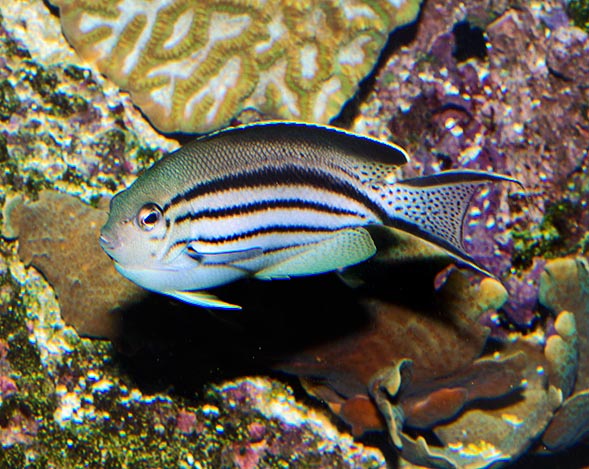Family : Pomacanthidae

Text © Giuseppe Mazza

English translation by Mario Beltramini
An easy to recognize Genicanthus lamarck male for the pectoral fins based blue spot © Giuseppe Mazza
The name of the genus comes from the Greek “genys, yos” = cheek and “akantha” = spine, with reference to the great spine at the base of the preoperculum.
The Latin name of the species lamarck honours, as Lacepède himself explains, the memory of Lamarck, or better, Jean-Baptiste Pierre Antoine de Monet, Chevalier de Lamarck (1744-1829), French naturalist, zoologist and botanist who hypothesized the first evolutionistic theory, the Lamarckism, related to the inheritance of the acquired characteristics.
Zoogeography
It is present in the tropical waters of the eastern Indian Ocean and of western Pacific. We find it, indicatively, at the Andaman Islands, in Thailand, Malaysia, Indonesia, New Guinea, Australia, Philippines, Taiwan and China up to the southern part of Japan. South-eastwards, it has colonized the Solomon Islands, Vanuatu and stops at the Australian Great barrier reef.
Ecology-Habitat
It lives in the lagoons, in relatively shallow and calm waters, but also on the outer slopes of the reefs, between the 10 and 30 m of depth, forming pelagic aggregations usually keeping far away from the bottom.
Morpho-physiology
The males, bigger, can reach the length of 25 cm, but it’s a species seldom exceeding the 20 cm.

Females' first black stripe is wide, the caudal is black edged and the ventral is white © Giuseppe Mazza
The dorsal fin shows 15 spiny rays and 15-16 soft rays, whilst the anal fin counts 3 spiny rays and 16-17 unarmed. The pectoral ones, triangular with rounded tip, have 16-17 soft rays and the ventral ones are pointed. The caudal is crescent-shaped, with a long filament on the two borders.
Given that it is a hermaphrodite protogynous species, with females which may transform in males and that there are therefore intermediate forms, we note a certain sexual dimorphism.
Both sexes have some longitudinal black stripes on pale grey background, and in both sexes the dorsal is black on top and pale below, especially at the extremity, whilst the anal and the caudal fins are and speckled with black.
But in the males we note a golden spot on the head and a showy blue zone at the base of the pectoral fins. The ventral fins are black and the prolongations of the caudal fin are white. Furthermore, from the eye start some irregular black traits.
In the females the ventral fins are, on the contrary, white, the first dorsal black stripe is much wider than the others and ends up in one of the two horizontal black stripes typical of the caudal. The juveniles have a livery similar to that of the females, but are, proportionally, shorter.
Ethology-Reproductive Biology
The Lamarck’s angelfish nourishes of zooplankton. The males usually control a small harem of 3-6 females, but are not particularly territorial and coexist peacefully with other males in the same zone. However, among them there is a precise hierarchical scale and the females prefer to join the dominant males.
The eggs and the larvae are pelagic. The populations take 1,4-4,4 years for redoubling, and the species has a moderate vulnerability index, of 30 on a scale of 100.
Synonyms
Holacanthus lamarck Lacepède, 1802.
→ For general information about FISH please click here.
→ For general information about BONY FISH please click here
→ For general information about CARTILAGINOUS FISH please click here.
→ To appreciate the BIODIVERSITY of BONY FISH please click here.
→ To appreciate the BIODIVERSITY of CARTILAGINOUS FISH please click here.
